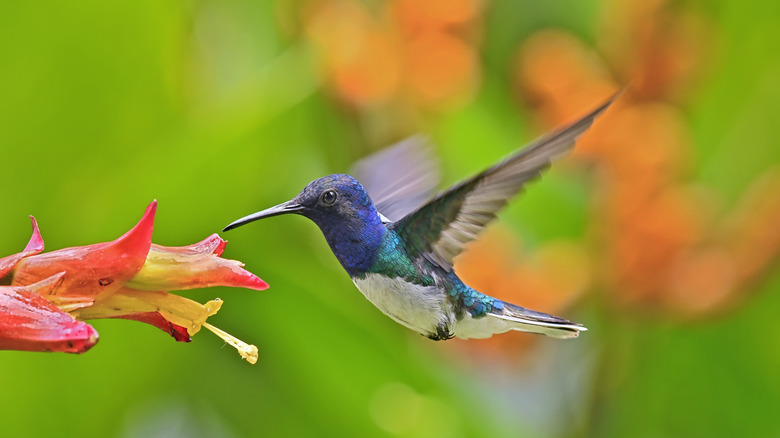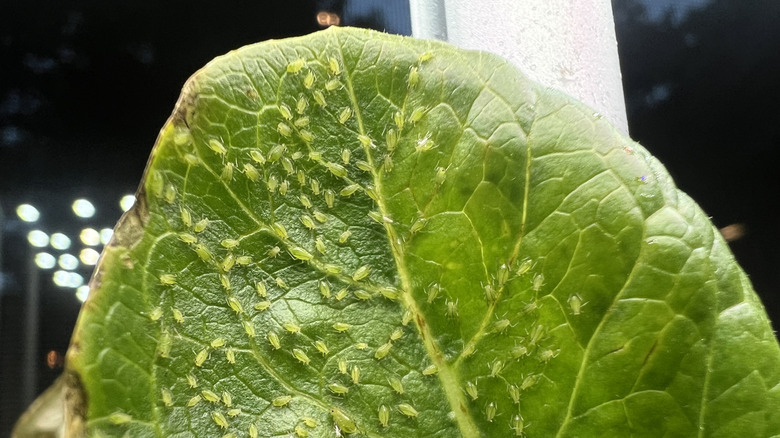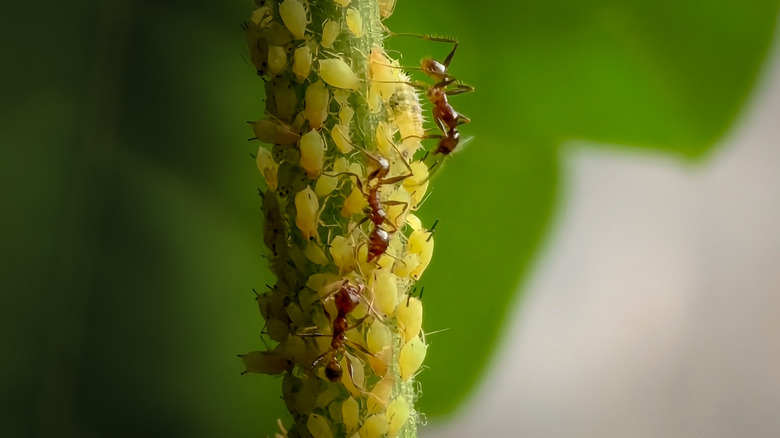The Common Insect Pest That Hummingbirds Will Love To Eat From Your Yard
There are dozens of striking flowers you can plant to bring hummingbirds to your yard, and it's well worth the investment of turning your garden into a hummingbird paradise. Hummingbirds are one of the main avian pollinators for wildflowers in the United States, affecting more than 60 families of flowering plants. These birds need to feed a whole lot; a hummingbird will eat its body weight in flower nectar every day to support its active lifestyle. Just the ruby-throated hummingbird beats its wings upwards of 70 times per second, maintaining a resting heart rate of 225 beats per minute. They don't only need carbohydrates and sugar from flower nectar; hummingbirds also require protein from eating insects and spiders. Almost 80% of a hummingbird's diet includes ants, fruit flies, mosquitos, and a common pest: aphids.
A hummingbird's list of prey centers on insects that are easy to capture and swallow on the go, as they generally do not slow down unless they have to. They're known to fall into a sleep-like state called torpor that's akin to hibernation on a shorter scale, slowing their metabolic functions when they can't maintain their average 105-degree body temperature. Aphids are a perfect candidate to eat because they can be found on most plants, (usually) cause little damage to the plants they're eating, and some species can produce up to 15 generations in a single growing season. If you want to maintain a strong hummingbird presence in your yard, growing plants that attract aphids, too, is a great place to start.
How aphids might affect your yard
With around 1,350 species of aphids populating North America alone, these soft-bodied insects could be found by hummingbirds in any number of places. Sometimes called "plant lice," aphids pierce a plant with sharp mouthparts to feed on sap, which then lets them produce sugary "honeydew" that attracts other insects like ants. Aphids form colonies on the tender areas of terminal growth, where flowering buds that never grow leave behind scar tissue, and female aphids can give birth 60 to 100 times within a month-long period. Excessive sap removal can cause a plant's leaves to wilt, but aphids will generally not affect a plant's health unless it's already sensitive to aphid saliva, becoming distorted and producing malformed fruit. Sooty mold can also develop on leftover honeydew, which can affect a plant's ability to photosynthesize.
About 25% of all plant species are infested with aphids, most commonly within the Asteraceae and Rosaceae families. Aphids are also frequently found in herb and vegetable gardens. Salvia, zinnias, peppers, cucumbers, melons, basil, celery, and snapdragons are among the plants most heavily infested by aphids. While this infestation isn't generally a problem, you can deal with too many aphids with a strong spray of water or pruning off irrevocably damaged foliage. However, natural pest control with hummingbirds is one key way of keeping aphid populations under control.
Creating an aphid-attracting garden will bring more benefits to your hummingbirds
Since aphids can pop up almost anywhere, you should probably focus your efforts on growing plants that will transform your space into a hummingbird haven. These include honeysuckle, birds of paradise, lilacs, and snapdragons — which, as mentioned, are also a big draw for aphids. Hummingbirds prefer to build nests in places with lots of cover, such as the limbs of trees and shrubs, so long as there is a lot of open area beneath those nests. It's also important to use as little chemical deterrent as possible in your yard. Pesticides and herbicides will kill off insects like aphids, and may damage both the plant life and hummingbirds themselves, so natural pest control is the way to go.
Aphids are a great food source in their own right, but hummingbirds will also be happy with the additional snacks that they attract. As mentioned, some species of ants will be drawn to aphid honeydew, and then work to protect aphids as their primary food producer. Ants might carry aphids to new plants, or even build shelters to protect them. This is just one means of transport for aphids, which can also spread via winged females looking for tender new plants to feast upon. Aphids tend to build up their populations during warm, humid springs, coinciding perfectly with hummingbirds returning from winter migration to feast on early season flowers before they move into the mountains.


